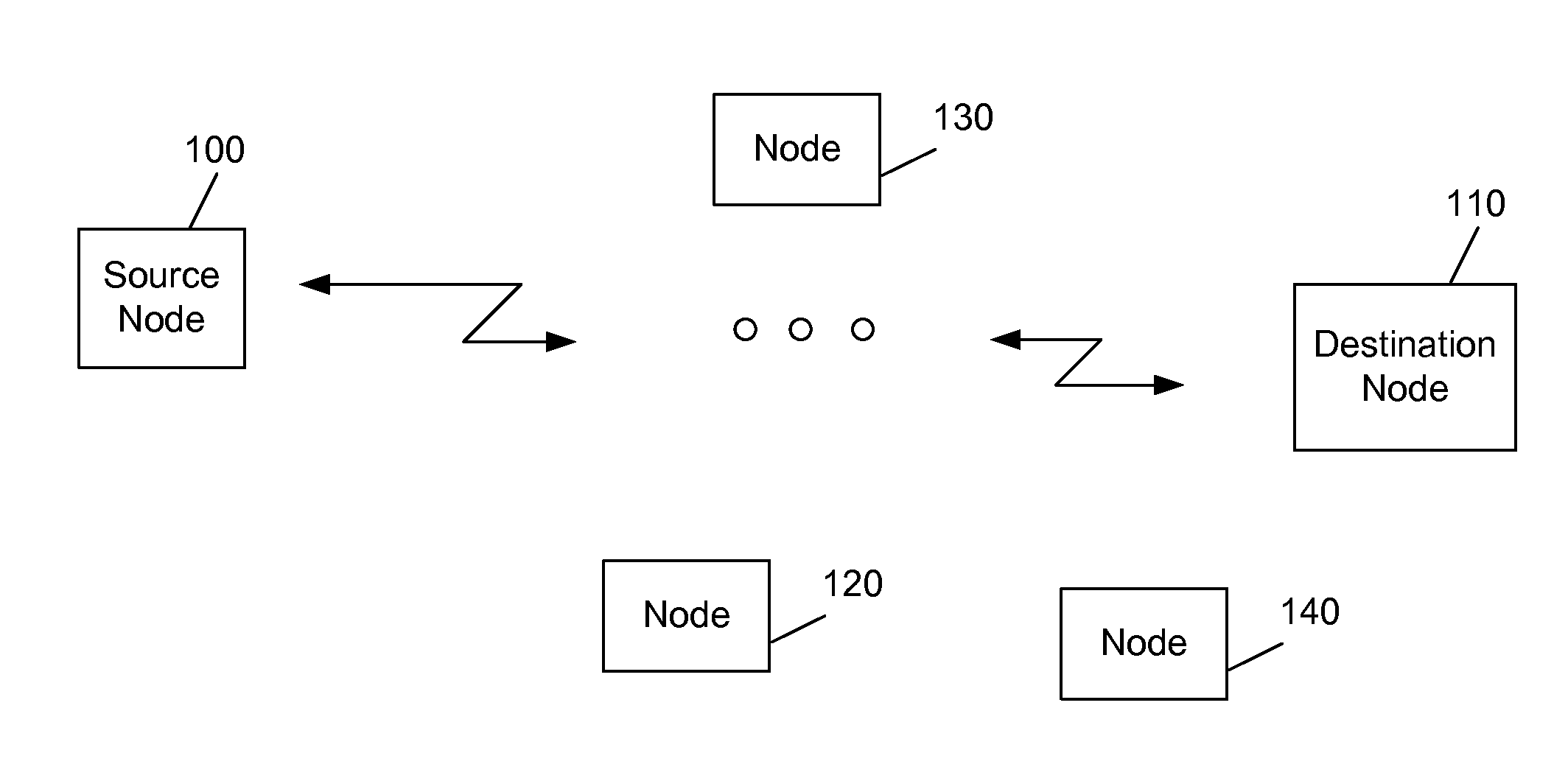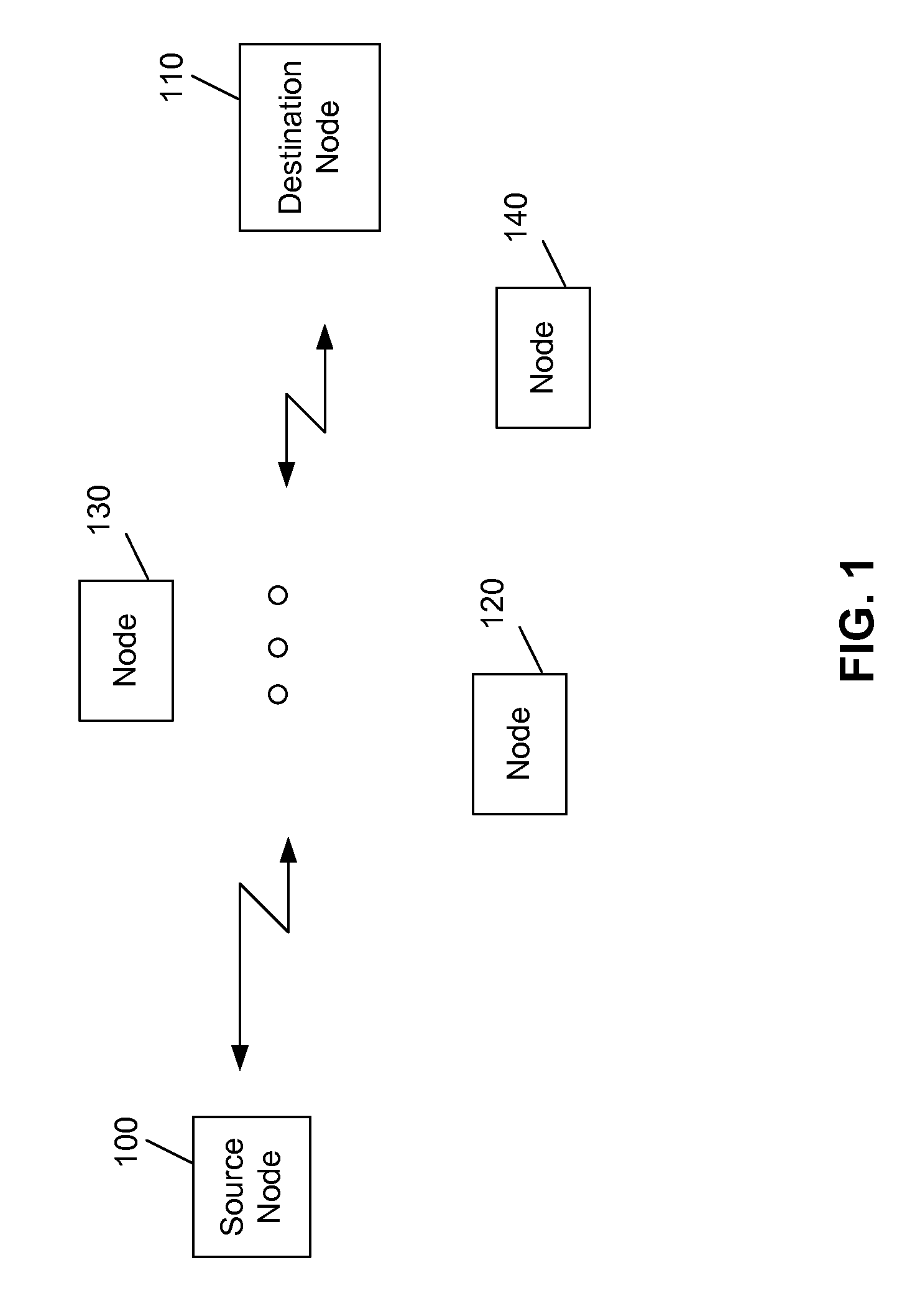Apparatus and method for transmission and recovery modes for an rts/cts system that utilizes multichannels
a multi-channel, transmission mode technology, applied in the field of apparatus and methods for wireless systems, can solve the problem of resetting the duration of the nav
- Summary
- Abstract
- Description
- Claims
- Application Information
AI Technical Summary
Benefits of technology
Problems solved by technology
Method used
Image
Examples
first embodiment
[0026]In an example that uses the first embodiment, as shown in FIG. 2, since the CTS frame is sent only on channels CH1 and CH2, which is a smaller bandwidth (e.g., 40 MHz) than the RTS bandwidth (e.g., 80 MHz), data is sent by the source node on the smaller bandwidth indicated by the CTS frame, and the amount of data that can be sent from the source node 100 to the destination node 110 is recomputed by each node receiving the RTS frame and CTS frame based on the NAV originally set by the RTS frame and the new, smaller bandwidth as provided in the CTS frame. That is, in the example shown in FIG. 2, because the NAV duration is set based on the RTS frame, the amount of data that can be sent is halved (e.g., from 1 GHz to 500 MHz), since the NAV duration remains the same. Once the NAV duration is finished, the RTS / CTS protocol allows for any node on the network to request to transmit over one or more channels to a destination node on the network, in a manner known to those of ordinary...
second embodiment
[0029]In a second implementation consistent with the second embodiment, the NAV duration is computed based on a minimum bandwidth and the amount of data to be sent from the source node 100 to the destination node 110, in which the minimum bandwidth may correspond to the bandwidth of only one channel in a multi-channel wireless environment. By way of example, this minimum bandwidth is 20 MHz, which the bandwidth of one channel. Other minimum bandwidth values may be utilized based on the channel requirements of a particular network, such as a minimum channel value of 1 MHz or 500 MHz, for example. In other implementations, the minimum bandwidth may correspond to a portion of a single channel, such as 5 MHz (¼ of a channel) in the example described herein.
[0030]In the second implementation consistent with the second embodiment, the NAV duration is set to a value based on the following equation:
NAV duration=Data Tx frame(s) time+CTS frame time+Ack frame time+3*SIFS,
[0031]in which the C...
third embodiment
[0036]In the third embodiment, the NAV duration is computed based on the bandwidth used by the RTS frame (e.g., the bandwidth of CH1, CH2, CH3 and CH4 combined) and the amount of data to be sent, subject to a maximum timeout limit (TXOP). In more detail, the NAV duration is set to a value equal to:
NAV duration=RTS1 frame time+Data Tx frame(s) time+CTS1 frame time+Ack frame time+3 SIFS.
[0037]In the third embodiment, the CTS1 frame is sent back from the destination node 110 to the source node 100 on the free channels with bandwidth information included. The CTS1 frame is preferably sent in duplicate mode with 11a preamble.
[0038]If the CTS1 frame is sent on a bandwidth smaller than the one included in the RTS1 frame, a second RTS2 / CTS2 exchange is performed between the source node 100 and the destination node 110, in which a new NAV duration is set to a value based on the bandwidth used by the RTS2 frame and the amount of data to be sent, subject to a maximum timeout duration (TXOP).
[...
PUM
 Login to View More
Login to View More Abstract
Description
Claims
Application Information
 Login to View More
Login to View More - R&D
- Intellectual Property
- Life Sciences
- Materials
- Tech Scout
- Unparalleled Data Quality
- Higher Quality Content
- 60% Fewer Hallucinations
Browse by: Latest US Patents, China's latest patents, Technical Efficacy Thesaurus, Application Domain, Technology Topic, Popular Technical Reports.
© 2025 PatSnap. All rights reserved.Legal|Privacy policy|Modern Slavery Act Transparency Statement|Sitemap|About US| Contact US: help@patsnap.com



